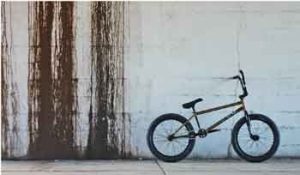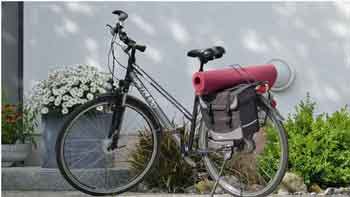Getting a lighter set of wheels or fancy electronic shifting is not the best performance enhancement you could make for your bike. However, air pressure is a well-deserved upgrade.
Inflating your tire shouldn’t take more than a few minutes of your time. However, it helps to know why bicycle tires are often inflated to a higher pressure.
Tires are often inflated to a higher pressure to support the rim. The air pressure in the tire is responsible for maintaining fabric tension everywhere on the tire except in one part; the contact patch.
Table of Contents
Why do you need to inflate your tires to a higher pressure
It’s no news that tires gradually lose air pressure if not properly set up. Tubeless tires and butyl tubes tires (the most prevalent variety) leak significantly less than lightweight latex tubes when correctly set up.
Air leaks from all tires, ranging from a few psi a week to severe leaks overnight. The rate of loss increases as pressure rises and this is as a result of external variables such as colder temperatures.
Having the right tire pressure on your bike is essential for safe riding. It helps to know that keeping the pressure in your tire within a specific range will have little to no effect. However, pushing the pressure outside the safe range can be dangerous.
Riding on low tires not only slows down your cycling, it also causes your tube and tire to wear out more quickly.
To boost performance, all it takes is a little more air pressure in the tires. Paying less attention to the quantity of air in your tires would give you an inaccurate reading.
The contact patch which is flattened against the road cannot be compressed by air pressure. This is because air pressure can only push outward, but in this situation, it pushes downward.
Because the weight load must be equal in magnitude to the downward force exerted by the air, the contact patch’s surface area is approximately equal to the weight load divided by the air pressure.
The tires are flat against the road, and the curvature of the sidewalls next to it expands. This lowers their tension and shallows the angle at which they approach the contact patch caused by the increased curvature.
These movements, which transmit the stress from the contact patch to the tire sidewalls, are responsible for the bulge that appears at the bottom of a tire while it is under pressure. The cloth threads are dragged outward rather than downward.
Additionally, the weight is transported in the same manner from the sidewalls to the rim. When you rotate a bicycle tire sideways, the forces acting on the tire’s right and left sides are equal and opposing, and they cancel each other out.
Most bicycle riders ask why they need to inflate their tires with more than the regular pressure. Though it is not compulsory to do so, it helps prolong the longevity of the rim.
The distance between the rims of your bike wheel and a pothole depends on the quantity of air pressure in your tires. While cycling, the added pressure keeps the tire from bottoming out and denting the rim.
Also, by controlling the pressure, you can select how much of the tread is in contact with the road and how much is not. This factor also influences rolling resistance.
Due to the higher pressure, the contact patch necessary to support the vehicle’s weight is smaller (pressure equals force over area). Therefore, the tire does not bend nearly as much as it would, otherwise, it stays rounder. As a result of reduced distortion, rolling resistance is lowered as well.
The trade-off is necessary because traction is a function of the contact patch area of a bicycle tire. While a greater amount of pressure reduces rolling resistance (which makes it easier to sustain momentum), a lesser amount of pressure enhances traction.
In addition, the pressure in a bicycle tire varies based on the bike and the tire. Mountain bikes frequently employ lower pressure tires with knobby treads in order to provide better trail grip.
On flat terrain, road bikes have higher pressure tires with smoother treads, which reduce rolling resistance and allow for faster acceleration.
The design of the tires, as well as the weight of the vehicle, both contribute to the fact that bike tire pressures are consistently higher than car tire pressures.
For instance, when conditions like poor traction are introduced, it could be challenging to slow down when driving a car with 110 pressure tires. Notwithstanding, mobility may also be difficult when riding a bike with 10 psi tires, due to excessive rolling resistance.
Note that it is not advised to apply the same amount of pressure to the front and rear tires.
How does the low air pressure in bicycle tires reduce the efficiency of a bicycle?
Under-inflation is the term used to describe when there is a decrease of air pressure in the tires. If the tires are underinflated, the tread of the tires will come into more contact with the road surface.
Tire deflection will increase because of the excessive flexing of the tire’s treads and sidewalls as the bike moves. An increase in internal heat will occur, in addition to the already increasing rolling resistance.
The treads on the tires will wear out more quickly, particularly near the sides. If a tire is underinflated, the tire loses its shape and becomes flatter than it should be when traveling down a road.
Additionally, the tread life of the tire could be reduced by up to 25% because of this condition. It is possible to increase the amount of deflection (bending) the tire experiences when it rolls by lowering the inflation pressure.
You may experience a significant drop in steering precision as well as overall stability.
While a decrease of 6 psi may not appear to be excessively low, keep in mind that it normally represents approximately 20% of the tire’s ideal pressure when compared to other pressures.
How to consistently check for air pressure in your bike tires

Depending on how experienced you are, you may be able to determine the air pressure of your tire by pinching it.
Also, you might be shocked to learn that bike tires require significantly more frequent inspections than vehicle tires.
So, it is best to always check the PSI of your tires, and here’s how:
Checking the air pressure with a gauge
No matter what kind of bike you are riding, the tires will always have a range marked on the side for you to refer to when you’re out on the trails.
To determine the pressure range, place your tire gauge on the valve and press down. This will cause the gauge’s needle to move and indicate the pressure range you selected.
To maintain proper pressure, alternate between the air pump and the pressure gauge. In addition, it is better to get a pump that comes with a built-in gauge.
Checking the air pressure without a gauge
Without a tire pressure gauge, you won’t be able to get an accurate reading of your tire pressure. However, there are a few options you can try:
- You can squeeze the tire of each side of the bike if you’re riding a road bike. If there is a lot of space to give, inflate it until you can barely squeeze it.
- If you’re riding a mountain bike, get on your bike and look down at the tires. If there is a lot of space to give, inflate it until you can barely squeeze it.
Pumping air into your bicycle tires will be necessary if they protrude more than a millimeter or two on either side. However, if the tires are rock solid and won’t budge, you will need to let some air out.
Why do smaller tires have higher PSI
The “PSI” (pounds of force acting on each square inch of the inside surface of the tire) allows your vehicle or bike to move on the pavement.
When it comes to your bike tires, having the appropriate PSI can make all of the difference in the world. To say that less air provides for a more comfortable ride and more air makes for a faster trip, on the other hand, is oversimplified.
This is true in many instances, but it is also true that proper inflation for optimal performance is dependent on the rider and their bike.
The stiffness of tire sidewalls does provide some support when a tire blows out, but without the cushion of air pressure, you’ll either have to sit there and wait for the tire to deflate or risk harming your tires if you attempt to drive without air pressure.
With smaller tires, the contact patch, or the area of the tire that comes into contact with the ground, is less. If this area is smaller, and your weight remains the same, more pressure is required to maintain the same weight in an appropriate manner.
Larger tires disperse the load over a greater surface area, needing less pressure to maintain the same amount of weight.

